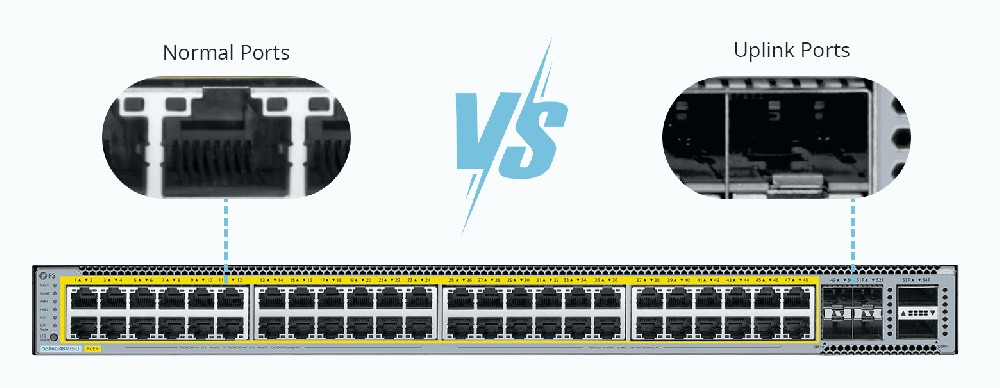Power over Ethernet (PoE) switches have revolutionized how network devices are powered and connected, simplifying the deployment of devices like IP cameras, VoIP phones, and Wi-Fi access points. A crucial yet often overlooked aspect of these switches is their uplink ports. This article delves into the importance of PoE switch uplink ports, exploring their functionality and vital role in modern networking environments.
An uplink port, often identified as Uplink, serves a specific role in data transmission within a network switch. Its primary function is to establish connections between lower-level networking devices like switches and hubs, and higher-level devices such as routers or servers. The purpose of the port is to effectively manage and direct data traffic from the lower-level devices to the higher-level ones, enabling communication across different network segments. By utilizing the port, the need for crossover cables is eliminated, preventing data looping between devices and ensuring smooth and efficient data flow within the network.

Direction of Data Traffic: Regular ports on a switch handle data traffic within the same network, connecting to end devices like computers and printers. In contrast, uplink serves the purpose of carrying data to a different network or subnetwork, establishing connections between the switch and higher-level devices such as routers or servers.
Use of Crossover Cables: When connecting similar devices, regular ports require the use of crossover cables to ensure accurate data transmission. However, uplink eliminates the need for crossover cables as it automatically corrects the information.
Handling of Data Packets: Regular ports handle data traffic on a unit-to-unit basis, sending packets individually to devices within the network. Conversely, uplink aggregates data packets from all other ports and directs them to higher-level devices or networks.
Prevention of Data Loops: To prevent data loops, which can occur if not managed properly, uplink ports are equipped with built-in mechanisms that ensure effective and efficient data flow within the network.
These ports on PoE switches play a critical role in effectively connecting switches within a network, facilitating both data transmission and power supply over a single Ethernet cable. Here are several reasons:
Bandwidth and Performance: Uplink typically offer higher bandwidth compared to standard ports. This makes them ideal for connecting switches, as they can handle the aggregated traffic from all connected devices on a switch without causing a bottleneck.
Scalability: When expanding a network, uplink is essential. They provide a straightforward and efficient way to connect new switches or network segments, allowing for scalability without significant reconfiguration.
Flexibility: They enable the connection of different switches (PoE or non-PoE), facilitating a flexible network structure that can adapt to changing needs.
PoE Passthrough: Certain PoE switches with uplink ports can pass PoE power to downstream devices or switches, enabling scenarios where devices far from the main power sources can still receive both power and data.
Efficiency: Reduces the need for separate power sources for devices like IP cameras, VoIP phones, and wireless access points, simplifying infrastructure and lowering costs.
Optimized Traffic Flow: Uplink is optimized for traffic flow between switches, ensuring efficient data transfer across the network backbone without unnecessary delays.
Less Congestion: Helps in reducing congestion on the network by segregating backbone traffic from local traffic on the switches.
QoS and VLANs: These ports support advanced network features such as Quality of Service (QoS) and Virtual LANs (VLANs), crucial for managing traffic priorities and segmenting the network, respectively.
Link Aggregation: They can be used in link aggregation (port trunking) to increase the connection speed and provide redundancy between switches.
Failover Support: In configurations supporting redundancy, uplink can be utilized to create multiple paths between switches. This ensures network availability and resilience by providing alternate paths for data in case of a link failure.
In scenarios where your company merges with or acquires an enterprise located more than 100 km away, and the goal is to integrate two separate networks into a single corporate environment, there is an alternative to investing in a completely new network infrastructure and migrating all users to it. Under specific conditions, it is possible to connect the networks using uplink.
If you work for a retail or tourism organization that experiences seasonal fluctuations in operations, there may be periods with only a few employees and devices, but during peak seasons, there is a need to rapidly scale up. Rather than maintaining an extensive and costly network infrastructure that remains idle during off-peak months, uplink can be utilized to expand the network by incorporating additional hubs, routers, and user devices during busy periods.
Similarly, if your organization has researchers conducting experiments in remote areas and transmitting substantial amounts of data back for analysis, an uplink port offers a faster and more reliable method of sending data to the cloud for processing. While advanced computing may not be required at the research location, the ability to transmit data quickly becomes crucial.
For these scenarios, the FS PoE switches stand out as an excellent solution. The uplink ports on S5860-48XMG-U enable high-speed data transfer and connectivity over long distances, facilitating seamless integration of disparate networks and ensuring data can be swiftly moved to necessary processing locations or the cloud. This feature is especially useful for organizations aiming to enhance their scalability and connectivity without overhauling their existing network infrastructure.
In conclusion, the uplink ports on PoE switches are not just additional features but are central to creating a robust, flexible, and efficient network. They facilitate seamless connections between various network levels, support expansion without extensive reconfiguration, and ensure efficient data and power distribution across devices. As networks evolve to meet growing demands, understanding and utilizing these ports effectively will be key to ensuring network reliability, performance, and scalability.
05-15
202405-10
202405-09
202405-08
202404-24
202404-23
202404-23
202404-08
202404-07
202403-26
2024
